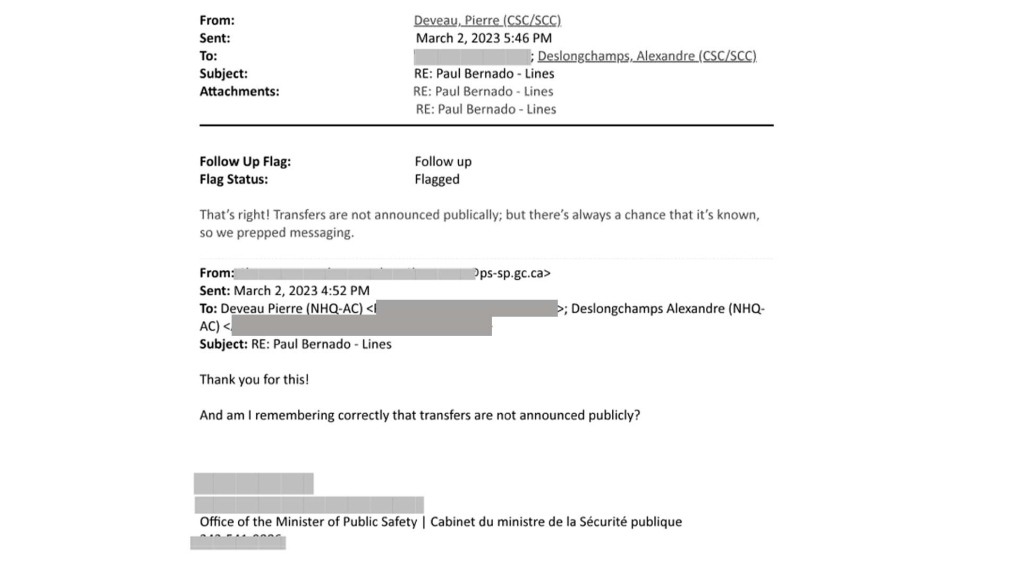Paul Bernardo transfer: How correctional services prepared for public reaction
Correctional Services Canada (CSC) started to plan its public response to Paul Bernardo’s transfer in January, nearly six months before the convicted killer was moved out of a maximum-security prison.
Documents obtained by CTV News Toronto through a Freedom of Information request reveal that staff acknowledged Bernardo’s transfer would “probably generate media attention” nearly half a year before it took place, and before the transfer was confirmed.
“Media and public interest remain high to date,” an email sent on Jan. 9 by a senior CSC media relations advisor reads.
“Mr. Bernardo has had two parole hearings, in October 2018 and June 2021, both of which generated considerable attention from the media, the victims and the public in general.”
- Download our app to get local alerts on your device
- Get the latest local updates right to your inbox
The 62-year-old killer is serving an indeterminate life sentence for the kidnap, rape, torture and murder of 15-year-old Kristen French and 14-year-old Leslie Mahaffy in the early 1990s. He was also convicted of manslaughter in the death of Tammy Homolka.
He was, and remains, designated as a dangerous offender.
For about a decade, Bernardo has been serving his sentence at Millhaven Institution near Kingston–a maximum security prison. On May 29, he was loaded into a vehicle and driven 4.5 hours non-stop to La Macaza Institution in Quebec.
The medium-security prison had been holding a bed for him since May 15, an April email shows.
 Paul Bernardo is shown in this courtroom sketch during Ontario court proceedings via video link in Napanee, Ont., on October 5, 2018. The Correctional Service of Canada is set to unveil the results of a review into the controversial transfer of notorious serial killer Paul Bernardo to a medium-security prison. THE CANADIAN PRESS/Greg Banning
Paul Bernardo is shown in this courtroom sketch during Ontario court proceedings via video link in Napanee, Ont., on October 5, 2018. The Correctional Service of Canada is set to unveil the results of a review into the controversial transfer of notorious serial killer Paul Bernardo to a medium-security prison. THE CANADIAN PRESS/Greg Banning
According to a February transfer assessment, also obtained by CTV News Toronto, Millhaven Management, the Security Intelligence Department and the Case Management Team–a group that assesses and supervises offenders during their sentence–“believe that this proposed transfer may draw less negative attention if it is out of the region where the index offences occurred.”
They noted in the report there are no viable alternatives in Ontario for Bernardo’s transfer.
DRAFT MESSAGING TIMELINE
A February email sent to Kirstan Gagnon, the assistant commissioner in the communications and engagement sector of the CSC, suggests the agency had prepared some lines for Bernardo’s transfer to a medium-security prison in August 2022 and that those same lines could be reused.
A series of revised “anticipatory media lines” were provided in a Feb. 28 email that would address questions relating to transfers and security classification assessments more generally. At this point, no firm date for the transfer had been confirmed.
The messaging contained technical details on the type of assessment the offender went through and when offenders are transferred. No specific case information was included.
On March 2, someone within the minister of public safety’s office reached out to CSC saying they were hearing that Bernardo would be transferred shortly. The name of the staffer has been redacted.
 Emails sent between Correctional Services Canada (CSC) and the Ministry of Public Safety in early March. The emails of the CSC staff have been blacked out by CTV News Toronto.
Emails sent between Correctional Services Canada (CSC) and the Ministry of Public Safety in early March. The emails of the CSC staff have been blacked out by CTV News Toronto.
The ministry’s office later asked for clarification about whether transfers are announced publicly.
In response, a communications manager within the CSC said that while transfers are not announced publicly, “there’s always a chance that it’s known, so we prepped messaging.” The same February talking points were then sent to their office.
MONTH OF TRANSFER
Emails about potential media queries picked up in late May days ahead of Bernardo’s physical transfer.
On May 23, Gagnon received an email from a colleague saying new “proposed messaging” had been cleared by their legal department.
The talking points were divided into subheads, including “top level,” “cascading security levels,” and “transfers.” The statements were a bit less technical than what was first proposed in February and further highlighted that public safety was taken into consideration.
The messaging make it clear that nothing has changed in relation to Bernardo’s sentence. It also included a statement on how difficult an inmate transfer can be for the victims, and messaging to use “if pressed” on whether the offender would eventually be transferred to a minimum-security prison.
This messaging was then sent to the Privy Council’s Office of the federal government on May 25. It was also received by staff within the Minister of Public Safety’s office.
The Prime Minister’s Office communications team was briefed the following morning, emails suggest.
Between May 30 and June 2, media requests began to flood CSC’s inboxes. No one confirmed, in email, that Bernardo had been transferred just days earlier.
One specific paragraph was circulated the most:
“Public safety is the paramount consideration in every decision made by the Correctional Service of Canada. While we cannot comment on the specifics of an offender’s case, we assure the public that this offender continues to be incarcerated in a secure institution, with appropriate security perimeters and controls in place. It is important to note that this offender is serving an indeterminate sentence, which means that there is no end date to their sentence.”
WHEN WERE VICTIMS NOTIFIED?
The family members of Bernardo’s victims were notified the morning of the transfer. The script for the conversation, which was redacted in the documents obtained by CTV News Toronto, was finalized on May 25.
An email sent on May 26 indicated concern about the “optics of notifying victims prior to the transfer occurring.” The staffer, who works within the CSC’s communications and executive services branch, noted that existing policy supports notification after the transfer is complete.
“My concern is that other victims may question why these particular victims were given advance notice,” the email reads. “I understand the compassion and decision making of this particular case, however, I want to be able to position the VSU (Victim Services Unit) to defend the potential questions arising from other victims.”
A review of the CSC’s decision to transfer Bernardo, released Thursday, found the branch went “above policy” to notify victims. However, it also said that additional steps should have been taken to provide “more proactive and meaningful discussions.”
Emails indicate that everyone except the lawyer for the victims’ families was notified by 1 p.m. on May 29.
Bernardo arrived at La Macaza Institution around the same time.
CTVNews.ca Top Stories

Trudeau asked Trump for California, Vermont to curb annexation talks
Justin Trudeau says U.S. president-elect Donald Trump kicked the tires on the potential annexation of Canada during their recent meeting in Florida, but the topic was quickly dropped when the prime minister countered with a request for two states.
Liberal leadership: Carney expected to launch bid next week, Clark organizing heavily, Gould considers entering
While longtime cabinet ministers Dominic LeBlanc and Melanie Joly have officially announced they have no plans to run for the Liberal leadership, several well-known faces are organizing behind the scenes to launch bids of their own.
BREAKING Two Alberta men sentenced for roles in 2022 Coutts border protest
Two Alberta men have been sentenced for their roles in the illegal Coutts border blockade in 2022.
Man dies after falling into sink hole at Fernie Alpine Resort
An investigation is underway by Elk Valley RCMP after a man died Wednesday after falling into a sink hole at Fernie Alpine Resort.
Amid tense backdrop, Canadian warship gets friendly message from Chinese vessel tracking movements
Daybreak on HMCS Ottawa began with a call over the marine radio from a Chinese warship. The call is coming from a Chinese Frigate known as the Yuncheng, the warship has been shadowing HMCS Ottawa through the South China Sea for two days and counting.
'Everything is gone': Sask. business owner loses Los Angeles home to wildfires
A Saskatchewan business owner lost her Los Angeles home as wildfires ravage parts of the city.
Trump gets no-penalty sentence in his hush money case, while calling it 'despicable'
U.S. president-elect Donald Trump was sentenced Friday to no punishment in his historic hush money case, a judgment that lets him return to the White House unencumbered by the threat of a jail term or a fine.
'Devastating beyond words': Paris Hilton shows remnants of home destroyed by L.A. fire
Socialite Paris Hilton shared a video showing her ravaged house, destroyed by the L.A. wildfires., 'I’m standing here in what used to be our home, and the heartbreak is truly indescribable,' Hilton wrote on Instagram.
Liberal leadership: Melanie Joly, Brian Gallant will not run, both focused on other matters
Foreign Affairs Minister Melanie Joly will not run for Liberal leadership. Up to now, Joly was widely considered a potential successor to Prime Minister Justin Trudeau. Former premier of New Brunswick Bran Gallant also confirmed to CTV News that he will not be in the running for Liberal leader.


































